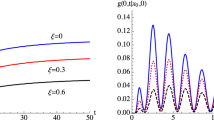Abstract
An artificial absorbing boundary is introduced in a linear birth and death stochastic process in order to understand the long time behavior of an ecological community. The solution is obtained by means of a spectral resolution of the probability distribution. A more general linear process with a coefficient of arbitrary strength near the boundary both with absorbing and with reflecting boundary conditions is also studied.
Similar content being viewed by others
References
N. G. van Kampen, Stochastic Processes in Physics and Chemistry, Elsevier (2004).
W. Feller, An Introduction to Probability Theory and its Applications, Vol. I, Wiley, NJ (1968).
C. A. Condat, Defect diffusion and closed-time distributions for ionic channels in cell membranes. Phys. Rev. A 39:2112–2125 (1989).
N. G. van Kampen and I. Oppenheim, Expansion of the master equation for one-dimensional random walks with boundary. J. Math. Phys. 13:842–849 (1972).
D. R. Cox and W. L. Smith, Queues, Methuen, New York (1961).
S. Karlin and J. McGregor, Linear growth, birth and death processes. J. Math. Mech. 7:643–661 (1958).
S. Karlin and J. McGregor, The classification of birth and death processes. Trans. Amer. Math. Soc. 86:366–401 (1957).
S. Karlin and J. McGregor, The differential equations of birth and death processes and the stieltjes moment problem. Trans. Amer. Math. Soc. 86:489–546 (1957).
M. E. H. Ismail, J. Letessier and G. Valent, Linear birth and death models and associated laguerre and meixner polynomials. J. of Approx. Th. 55:337–348 (1988).
S. P. Hubbell, The Unified Neutral Theory of Biodiversity and Biogeography, Princeton University Press, NJ (2001).
I. Volkov, J. R. Banavar, S. P. Hubbell and A. Maritan, Neutral theory and relative species abundance in ecology. Nature 424:1035–1037 (2003).
I. Volkov, J. R. Banavar, F. He, S. P. Hubbell and A. Maritan, Density dependence explains tree species abundance and diversity in tropical forests. Nature 438:658–661 (2005).
S. Pigolotti, A. Flammini and A. Maritan, Stochastic model for the species abundance problem in an ecological community. Phys. Rev. E 70:011916 (2004).
S. Karlin and H. Taylor, A First Course in Stochastic Processes, Academic Press (1975).
W. Feller, Two singular diffusion problems. Ann. of Math. 54:173–182 (1951).
W. Ledermann and G. E. H. Reuter, Spectral theory for the differential equations of simple birth and death processes. Phil. Trans. Royal Soc. Lon. A 246:321–369 (1954).
R. C. F. Bartels and R. V. Churchill, Resolution of boundary problems by the use of a generalized convolution. Bull. Am. Math. Soc. 48:276–282 (1942).
R. Courant and D. Hilbert, Methods of Mathematical Physics, Wiley (1989).
I. N. Sneddon, Elements of Partial Differential Equations, McGraw-Hill (1957).
F. G. Tricomi, Integral Equations, Dover (1985).
M. Abramowitz and I. A. Stegun, Handbook of mathematical functions. Nat. Bur. of Stand. (1964).
N. N. Lebedev, Special Functions and their Applications, Dover (1972).
T. S. Chihara, An Introduction to Orthogonal Polynomials, Gordon & Breach, New York (1978).
A. Erdélyi, W. Magnus, F. Oberhettinger and F.G. Tricomi, Higher Trascendental Functions, Vol. II, McGraw-Hill, New York (1953).
E. T. Whittaker and G. N. Watson, A Course of Modern Analysis, Cambridge University Press (1963).
I. S. Gradshteyn and I. M. Ryzhik, Table of Integrals, Series and Products, Academic Press (2000).
Author information
Authors and Affiliations
Rights and permissions
About this article
Cite this article
Azaele, S., Volkov, I., Banavar, J.R. et al. Linear One-Step Processes with Artificial Boundaries. J Stat Phys 125, 491–511 (2006). https://doi.org/10.1007/s10955-006-9158-z
Received:
Accepted:
Published:
Issue Date:
DOI: https://doi.org/10.1007/s10955-006-9158-z




